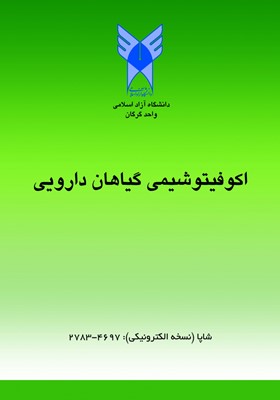تأثیر کاربرد سطوح مختلف کودهای آلی بر خصوصیات کمی و بیوشیمیایی گیاه دارویی (Salvia mirzayanii Rech. f. & Esfand)
محورهای موضوعی : Medicinal Plantsمهدی قسمتی 1 , فرید مرادی نژاد 2
1 - علوم باغبانی دانشکده کشاورزی دانشگاه بیرجند
2 - دانشیار گروه علوم باغبانی و مرکز پژوهشی گیاهان ویژه منطقه دانشکده کشاورزی، دانشگاه بیرجند
کلید واژه: کمپوست زباله شهری, کود گاوی, کود گوسفندی, مورتلخ,
چکیده مقاله :
به دلیل عدم آگاهی از پرورش مورتلخ (Salvia mirzayanii Rech. f. & Esfand) این گیاه به صورت غیر اصولی و بی رویه از عرصههای طبیعی مناطق جنوبی برداشت میشوند بنابراین برنامههای توسعه کشت و پرورش گیاه ضروری بهنظر میرسد. در زمستان 1396 در مزرعه تحقیقاتی جهاد کشاورزی شهر لار آزمایشی جهت بررسی اثرات کودهای آلی شامل کود گوسفندی (20 ،40 تن در هکتار)، کود گاوی (20 ، 40 تن در هکتار)، کمپوست زباله شهری (10 ،20 تن در هکتار)، ورمی کمپوست (20 ،40 تن درهکتار) و شاهد (عدم مصرف کود) بر صفات کمی و شیمیایی گیاه مورتلخ در قالب طرح بلوکهای کامل تصادفی با 4 تکرار انجام شد. اواسط فروردین کل اندام رویشی گیاهان برداشت و وزن تر و خشک گیاه اندازهگیری شد و همچنین میزان آنتی اکسیدان کل، فنول و فلاونوئید برگ به روش اسپکتروفتومتری و درصد اسانس با روش تقطیر با آب و به وسیله دستگاه کلونجر تعیین گردید. نتایج نشان داد که بیشترین مقدار وزن تر و خشک بوته از تیمار 10 تن در هکتار کمپوست زباله شهری بدست آمد. بیشترین مقدار آنتیاکسیدان کل، فنول و فلاونوئید در تیمار 40 تن کود گاوی مشاهده شد. از بین تیمارهای مورد آزمایش فقط تیمار 10 تن در هکتار ورمی-کمپوست توانست افزایش معنیداری در مقدار اسانس نسبت به شاهد نشان دهد. بطورکلی وزن تر و خشک بوته بیشتر تحت تأثیر کود کمپوست زباله شهری افزایش یافت. تأثیر کودهای دامی بر مواد موثره نسبت به کود کمپوست بیشتر بود. و مقدار اسانس گیاه فقط تحت تأثیر ورمیکمپوست افزایش یافت.
Due to unawareness of production method, improper uses and too much harvested this plant (Salvia mirzayanii ) natural of southern arenas, it seems that developing plans for its production is necessary. The experiment was carried out in the field research of Jahad Agricultural Center of Larestan, Fars province duoring winter 2017. The effects of different organic fertilizers including sheep manure (20 and 40 ton/ha), cow manure (20 and 40 ton/ha), compost (10 and 20 ton/ha), vermicompost (20 and 40 ton/ha) and control on physicochemical and quality traits Salvia mirzayanii were investigated in a complete random block design with four replications. Early in April, all vegetative organs of plants were harvested and dry and fresh weight of plantwere measureal. Also, the amount of total antioxidant, phenol and flavnoide of leaves were determinal spectrophtometi while essential oil percentage were determined distillation method with water and by Clevenger apparatus. The results showed that highest fresh and dry weight of the plant was obtained from the treatment of 10 ton/ha of compost. The highest amount of antioxidants, phenol and flavonoid total were observed in 40 ton/ha of cow manure treatment. Among applied the treatments only 10 ton/ha vermicompost significantly increased the amount of essential oil compared to control. In general greater fresh and dry weight of plant increased by compost fertilizers. Effect of manure on phytochemicals was higher than compost, and essential oil value of plant increased only by vermicompost application


